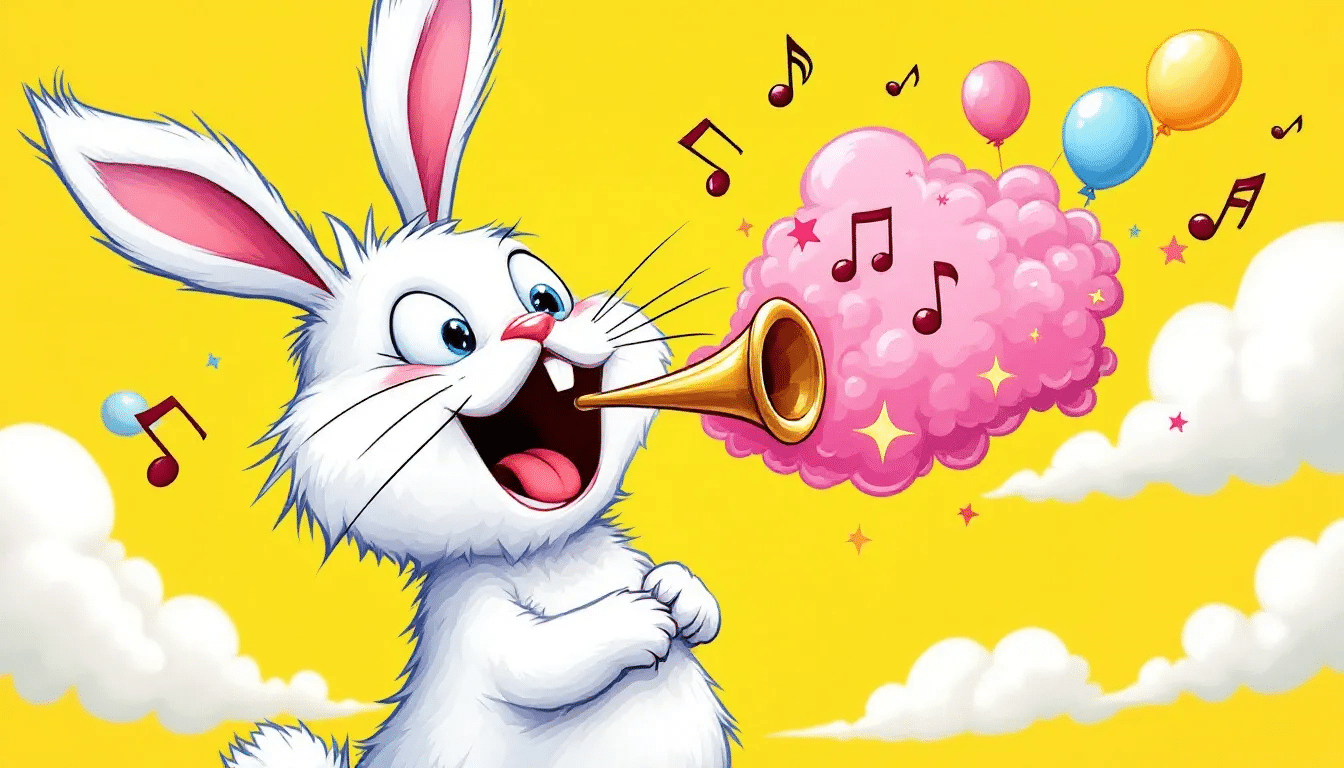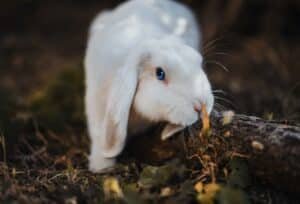A rabbit honk is a soft, buzzing sound often signaling excitement or joy. Bunnies can exhibit honking behavior, which is similar to the hiccup-like symptoms they sometimes show. Learn why your rabbit makes this noise and what it reveals about their mood.
Key Takeaways
- Rabbit honking is a gentle sound that signifies joy and excitement, usually occurring during playful moments or when anticipating treats.
- Recognizing rabbit body language and happy noises, like purring and clucking, helps in understanding their emotional state and ensuring their well-being. A rabbit’s purring, much like a cat’s purr, signifies contentment. However, unlike a cat’s purr, rabbit purring can easily be mistaken for teeth grinding, which indicates pain.
- While honking is normal, it’s essential to distinguish it from distress noises like loud squealing or grinding, which may signal health issues requiring veterinary attention.
Rabbit Communication Basics
Rabbits communicate primarily through body language, but they also use a variety of vocalizations to convey their emotions and needs. Understanding these vocalizations is essential for building a strong bond with your pet rabbit. Rabbits use different sounds to indicate happiness, fear, anxiety, and pain. By recognizing these sounds, you can provide better care and ensure your rabbit’s well-being.
Rabbits are generally quiet pets, but when they do make noises, it’s important to listen closely. For instance, a rabbit’s honk is a happy noise, often signaling excitement or joy. On the other hand, a rabbit scream is a distress signal, indicating severe pain or fear. By paying attention to these vocal cues and their accompanying body language, you can better understand your rabbit’s emotional state and respond appropriately.
What is a Rabbit Honk?

Imagine the delight of a rabbit anticipating its favorite treat or the joy of playful interaction. This excitement often manifests as a soft, buzzing noise known as a honk. Unlike the loud and alarming rabbit scream, the honk is a gentle sound, indicating positive emotions.
Rabbits often honk when they are happy or playful, adding a fascinating dimension to their behavior and emotions. Honking can also serve as a communication method with other rabbits, signaling their social dynamics and emotional responses.
Whether engaged in play or simply feeling joyful, the honk reflects their happy noise in those moments.
Types of Rabbit Noises
Rabbits make various noises, each with a specific meaning that can help you identify their emotional state. For example, a rabbit’s cluck is a soft, low-pitched noise made when they are enjoying a tasty treat, indicating satisfaction and pleasure. Purring, which sounds like gentle teeth grinding, signals contentment and relaxation, much like a cat’s purr.
On the flip side, a rabbit growls when they feels threatened or annoyed, and screaming rabbits are in severe pain or distress, requiring immediate attention. By familiarizing yourself with these noises, you can better understand your rabbit’s needs and provide appropriate care. Recognizing these sounds and their meanings is a crucial aspect of rabbit care, ensuring your bunny feels safe and loved.
Why Do Rabbits Honk?

A rabbit’s honking, a soft buzzing sound, often indicates playfulness or excitement. It’s their way of expressing joy and engaging in social interactions.
Rabbits often honk when excited, like anticipating treats or playtime. This sounds like it highlights their eagerness and pleasure.
Honking also occurs in social contexts where rabbits interact. Recognizing these nuances helps create an enriching environment, ensuring their happiness and well-being.
Recognizing Happy Noises in Rabbits
Identifying happy noises is crucial for understanding rabbit well-being. For instance, rabbits purr by gently rubbing their teeth together, signaling contentment and relaxation, often during petting or massages. This is similar to a cat’s purr, which also indicates happiness, though the sounds originate differently. While a rabbit’s purr can be mistaken for teeth grinding, which indicates pain, a cat’s purr is more consistently a sign of contentment.
Rabbits also make a rabbit’s cluck, a soft, low-pitched noise, when enjoying a tasty treat. This distinct sound, different from a chicken’s cluck, indicates their satisfaction and pleasure, often heard when they are feeding, sleeping, or feeling satisfied.
Male rabbits may hum to attract females, showcasing their happy mood. Circling your feet, often with honking, signifies excitement and affection.
The ‘binky’, a joyful leap and twist in the air, and the ‘flop’, lying on their side, are other signs of extreme happiness and relaxation. Watching these behaviors and noises together helps accurately gauge your rabbit’s emotional state.
Body Language Accompanying Rabbit Honks

Recognizing the body language accompanying rabbit honks offers deeper emotional insights. For example, forward ears suggest alertness, while drooping ears signify relaxation. These ear movements often accompany honking, offering clues about their feelings.
Different sounds, like a rabbit’s cluck or grunting, can indicate different emotions. A rabbit’s cluck does not sound like a chicken’s but is more subdued, while grunting sounds are higher pitched and can indicate stress or a desire for space.
Quick hops or zooming around usually indicate joy and high energy, often coinciding with honking. These behaviors suggest a happy, healthy bunny. Standing on hind legs shows curiosity and a desire to explore.
Circling you while honking signals happiness and a desire for attention. Respecting their boundaries and allowing them to initiate interactions fosters confidence and comfort.
Watching these body language cues alongside honking helps better understand your rabbit’s needs and emotions.
Is Rabbit Honking Normal?

Rabbit honking is a perfectly normal behavior, often expressing joy and excitement. This natural vocalization shows happiness and a desire for attention and shouldn’t raise concern.
Honking is part of a rabbit’s natural emotional expression. Understanding it strengthens the bond with your bunny, ensuring they feel loved and well-cared for.
When to Be Concerned About Rabbit Noises
While honking indicates a content rabbit, certain noises signal distress or health issues. Loud squealing or a rabbit scream often indicates severe pain or distress and requires immediate attention. These distress noises can also alert other rabbits, signaling them to potential danger or discomfort.
Loud teeth grinding, unlike gentle purring, suggests pain or stress and needs monitoring. Continuous wheezing indicates a respiratory problem needing veterinary attention. Fast, audible breathing or mouth breathing are signs to take your rabbit to a vet immediately.
Recognizing these signs allows for prompt health issue management, ensuring your rabbit stays healthy and happy.
Creating a Stimulating Environment
Creating a stimulating environment is crucial for your rabbit’s physical and mental health. Rabbits are naturally curious creatures and need plenty of opportunities for exercise, play, and exploration. Providing a variety of toys, hiding places, and climbing structures can help keep your rabbit engaged and active. Additionally, offering a range of healthy foods and treats can help stimulate your rabbit’s sense of smell and taste.
A stimulating environment reduces stress and boredom, promoting overall well-being. For instance, introducing new toys or rearranging their habitat can reignite their curiosity. Engaging play areas with obstacles and tunnels stimulate their natural behaviors, while a balanced diet of grass hay and leafy greens ensures they stay healthy. By creating a dynamic and enriching environment, you can help your rabbit lead a joyful and fulfilling life.
How to Encourage Happy Noises
Encouraging happy noises in rabbits involves providing a spacious, comfortable home base for relaxation and play. Introducing new toys or rearranging their environment can reignite curiosity and engagement. Bunnies, for instance, exhibit happy noises when they are in a stimulating environment.
Facilitating natural behaviors like digging and chewing safely enhances happiness. A balanced diet of grass hay and leafy greens contributes to well-being, while occasional treats motivate joyful running and jumping.
A variety of chew toys keeps rabbits occupied and prevents boredom. Engaging play areas with obstacles and tunnels stimulate curiosity. Bonding with a companion enhances happiness by fulfilling social needs.
Regular exercise and positive reinforcement training boost a rabbit’s joy and confidence.
Summary
Understanding the various noises rabbits make, especially the honking, is crucial for ensuring their happiness and well-being. From recognizing happy noises like purring and clucking to knowing when to be concerned about distress signals, being attuned to your rabbit’s sounds can greatly enhance your bond.
By creating an environment that encourages happy noises, you can ensure your bunny leads a joyful and healthy life. Remember, a happy rabbit is a content and well-cared-for pet.
Frequently Asked Questions
What does it mean when a rabbit honks?
When a rabbit honks, it means they are excited or feeling playful, showing their happiness. It’s a delightful sound that reflects their joyful mood!
Are rabbit honks normal?
Absolutely, rabbit honking is a normal behavior that shows they’re feeling joyful and excited! It’s a cute way for them to communicate their happiness.
What are some happy noises rabbits make?
Rabbits make happy noises like purring, clucking, and humming, and you’ll know they’re enjoying themselves when they do a ‘binky’ or flop over!
When should I be concerned about rabbit noises?
You should be concerned if your rabbit makes loud squealing, screaming, or continuous wheezing, as these sounds often signal severe pain or distress. It’s best to consult a vet if you hear these noises.
How can I encourage happy noises from my rabbit?
To encourage happy noises from your rabbit, create a cozy space with plenty of toys, maintain a balanced diet, and interact with them regularly. This helps them feel secure and loved, leading to those delightful sounds!



